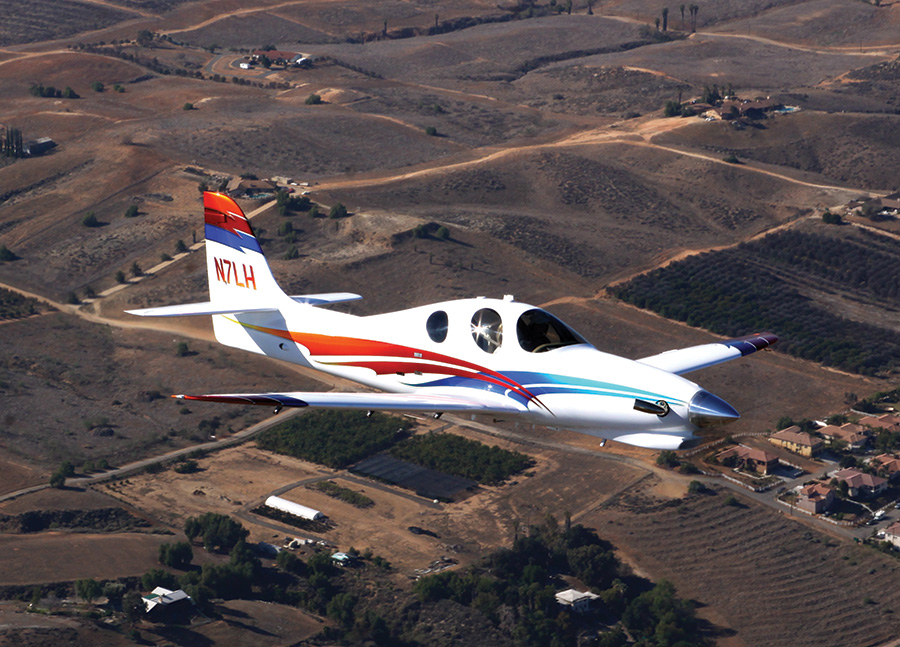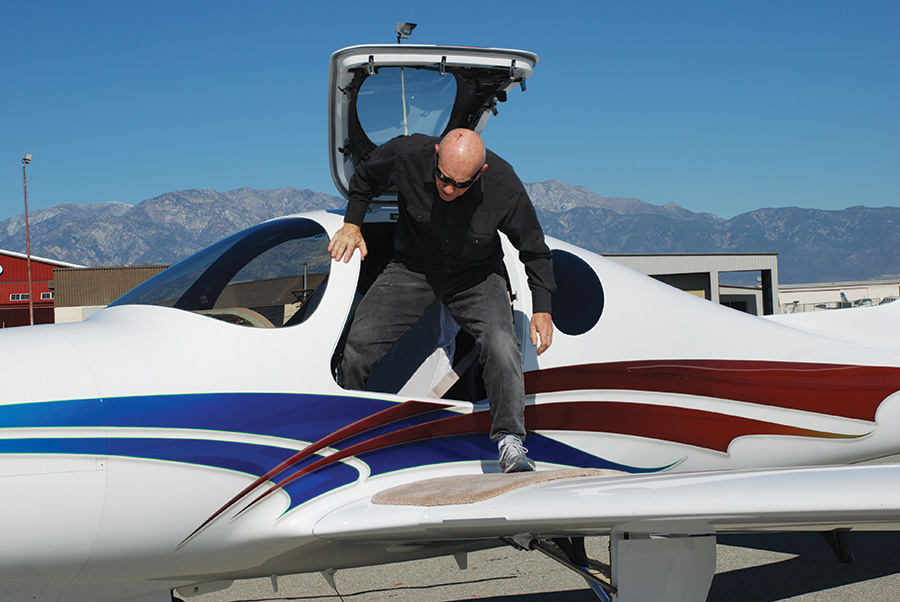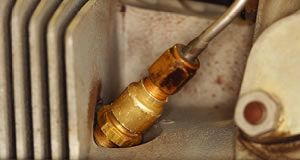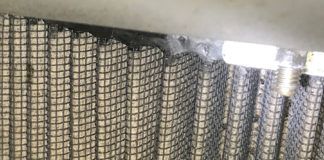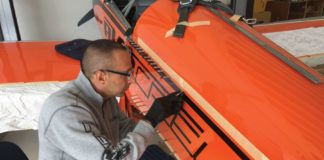The last time we heard from Wendell and Martha Solesbee, they had just received the airworthiness certificate for their Lancair Evolution. That was a year ago. Those heady days of the first flight and Phase I test flying quickly swirled into anticipation of AirVenture. There was no time to look back because there was too much to look forward to. The Solesbees were thrilled with the results of their hard work to be sure, but what was it going to be like to live with this beautiful airplane? Would it sit Ferrari-like in a hangar, where its stunning lines and sensuous form would be sheltered from the rigors of regular use, for which it might prove to be ill-suited? Or would it reveal itself to be one of those rare gems of design and execution in which form and function blend to create a near-perfect traveling machine? Only time could answer such questions.
If the former champion of getting from point A to point B in an airplane quickly was the Lancair IV-P, then how does the new Lancair Evolution stack up? The Solesbees, having built and flown both, would be in a particularly good position to shed some light on this subject. Is the Evolution really the ultimate upgrade, or is it just one of the most expensive Experimental/Amateur-Built airplanes ever conceived?
Silver Lindy at AirVenture 2012
N7LH is a gorgeous airplane inside and out. It is truly difficult to find a flaw in it anywhere, but there are a lot of good looking airplanes at Oshkosh every year. Taking any kind of award there is not easy. With a Silver Lindy on their shelf for their older Lancair IV-P, the Solesbees knew it was possible—but far from easy—to win at AirVenture. Their hopes were high but their feet were still firmly on the ground as they approached the competition. After a week of showing off their plane and talking to judges, the Solesbees ended up with another Silver Lindy (Reserve Grand Champion Kit-Built Airplane), eclipsed by another stunning Lancair with an engine compartment full of chrome. The engine bay of their Evolution is very nicely assembled, but it just never occurred to them that they should take their Pratt & Whitney PT-6 apart and have it chrome plated. On such a decision their fate was determined. Such a shortcoming takes nothing away from the beauty of N7LH as it sits on the ramp or flies through the air, but the bragging rights of a Grand Champion have once again eluded them.
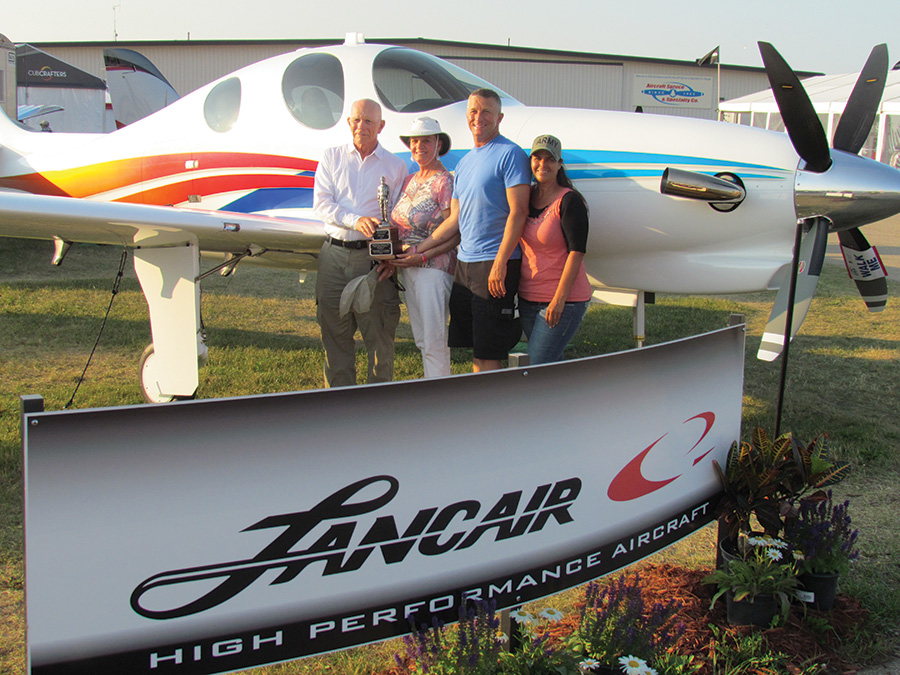
The Solesbees pose with their well-deserved Silver Lindy at AirVenture 2012. From left to right are Wendell Solesbee, Martha Solesbee, their son Terry, who did most of the work on the award-winning paint job, and his wife Marisela.
A Step Up in Comfort
When the Solesbees decided to build their Evolution, they wanted a travelling machine that would improve upon what they already had: a Lancair IV-P. With over 120 hours of flying time in the Evolution, they are now in a position to look back and evaluate the results of their effort. The Evolution’s track record so far has not been perfect, but all things considered, it has been pretty good, with the promise of getting even better. Performance has met expectations in every regard. And comfort is clearly superior to the IV-P: more cabin room, more baggage capacity, better air conditioning, and quieter. The IV-P is nice, but the Evolution is really nice.
The larger fuselage of the Evolution makes long trips more comfortable with extra width and headroom. There’s also a larger door into the cabin to ease ingress/egress. The extra carrying capacity of the cabin has plenty of room for baggage, and the useful load will actually allow four standard passengers to take off with full fuel—fuel that will take you 1000 miles or more.
A great feature of the Evolution, and one much appreciated by the Solesbees, is air conditioning that really works on the ground. Southern California can get pretty warm in the summertime, so it’s pretty nice to be able to cool off the cabin with the flick of a switch on a 100° day. The powerful Pratt & Whitney turbine handles this chore effortlessly.
Performance in the Air
Overall comfort is clearly better, but how does the Evolution fly? Around the pattern at 90 knots produces none of the heartburn that it would in a IV-P, and coming over the fence at 80—or even 75 knots—is quite comfortable. Landing in less than 2000 feet is a non-event at Chino’s 650-foot field elevation,
especially with the help of the reverse thrust (BETA) available with the turbine engine. No IV-P driver would ever consider flying around at such speeds. Even more noteworthy was Wendell’s willingness to demonstrate a stall at 5500 feet in the Evolution. Nobody stalls a Lancair IV-P at 5500 feet on purpose. The confidence that the low-speed handling of the Evolution inspires may be one of its most valuable improvements over the IV-P.
In cruise, the Evolution fairly begs to go high, but the Solesbees prefer to fly at 16,500 to 17,500 feet, giving away some of the speed and fuel economy that would be available at higher altitudes. They typically see cruise speeds of 260 knots or so at 36 to 38 gallons of Jet-A per hour. They have gone higher where 300 knots is achievable, but they prefer the upper end of the VFR altitudes for most of their flying. In this configuration, the Evolution is giving them about the same cruise speed as the IV-P, but at twice the fuel flow. Wendell Solesbee notes this often when you ask him about how the planes compare. “The IV-P is just more economical,” he says. There is still something in him that is a little bit appalled at paying $400 or more for fuel after a short, two-hour flight.
When you ask Martha Solesbee to describe the Evolution, her response comes out with a smile in one word, “smooth.” I concour. When the throttle goes forward, you are pressed back in your seat by a smooth, strong, vibration-free push that is unlike anything a piston-powered plane can deliver. It seems almost effortless as it climbs into the sky at 3000 feet per minute or more.
Lancair IV-P owners will interject, “We climb out pretty well ourselves,” which is true, but the IV-P will only do so after eating up what seems like a mile of runway, and then with none of the easy confidence of the Evolution. To fly both of them is to feel the difference. There is no comparison.
The Solesbees look at the Evolution and the IV-P as pretty much equal in performance on a practical level. With just the two of them aboard most of the time, either plane will get the job done. The Evolution opens up access to many airports with shorter runways, but that is a benefit seldom used by Wendell and Martha as they travel around the country. What it seems to come down to is that the Evolution doesn’t do so much more than the IV-P, but it just does everything so much smoother and easier.

The Lancair Evolution panel is state of the art, conceding nothing to its certificated competitors that cost millions more.
Avionics
Sliding into the cockpit of the Evolution greets you with a dazzling array of state-of-the-art Garmin avionics. The center armrest has a keypad for data entry, and every other imaginable convenience is there at your fingertips. The panel includes the full Garmin G900 system, the experimental version of the G1000 equipment now found in many new certified airplanes. To that the Solesbees have added the Garmin 3-axis autopilot and an Avidyne TAS traffic advisory system. The Garmin autopilot can manage the entire flight, and only lacks an auto-throttle to match airline capabilities. The Avidyne TAS also matches airline systems in performance. Any plane with a transponder shows up with position and relative altitude information on the Garmin screens. At 200-plus knots, it is very nice to have such a vivid and accurate display of surrounding traffic, because at those speeds, simple see-and-avoid can come up a bit short when things get busy. This may not quite be the ultimate panel, but it is pretty close. Certainly few airplanes, amateur-built or not, will have better.
Trips
The Evolution was made to eat up real estate, and when you can easily cover 1000 miles before lunch, where you can go with your airplane expands considerably. The Solesbees can fly from Chino to Portland in three hours or Chino to Phoenix in just over one hour. How cool is that? The Solesbees’ longest trip so far was their annual pilgrimage to AirVenture. That trip got lengthened with the unexpected detour to the funeral of Martha’s brother in nearby Illinois. Since then, a number of destinations in Oregon and Arizona have filled up their travel plans. They are even considering a trip to Belize in Central America, but they are not entirely confident they can grapple with the required international paperwork. It would be a shame though, to leave such a nice plane at home and pile into the big aluminum tube with the masses that have no other choice.

The Solesbees previously built a Lancair IV-P prior to tackling their Evolution project. Here is Lancair N4LK in flight. Daughter Sabrina Solesbee took this picture from Barry Hancock’s Lancair Legacy.
A Problem or Two
A year of Evolution flying has been largely—but not entirely—trouble-free. As with any new design, there were a few teething problems. Many of these were solved during construction, but a few remain. The original autopilot worked, but not as well as the Solesbees would have liked. It was replaced with a Garmin autopilot, which fits more seamlessly into the Garmin avionics package, and whose stronger servo motors can better handle the heavy ailerons of the Evolution. This is a factory-only option for the Lancair, but the Solesbees are happy with the improved performance, even if it did cost more than they originally planned to spend on an autopilot.
A problem that has yet to be fully resolved is the seal between the windows and the fuselage. As the airplane expands with each pressurization cycle, it puts a lot of stress on the bonds that hold the windows in place. There is no risk of the windows blowing out, but the bonds do tend to crack over time. Lancair now seems to have a solution worked out, but the Solesbees are waiting for it to get some time in the field before they go ahead with the retrofit. Other issues have been few and minor in the first 120 hours.
The Final Verdict
So, is the Evolution the ultimate upgrade the Solesbees had hoped it would be? Their answer to that is yes. Was it worth building a new plane that cost twice as much and then some as their IV-P and then burns twice as much fuel to go about the same speed? With just the slightest bit of reluctance, the answer to that is yes, too. The quiet confidence that the Evolution’s smooth power and docile handling provide are worth every bit of the extra cost if you can afford it. A well-engineered turbine airplane is just in another class, which is evident as soon as you push the throttle forward for the first time. There is no doubt that the cost is much higher for performance that doesn’t look that much better on paper, but there are benefits that cannot be measured in cruise speeds or time-to-climb numbers. The Solesbees have experienced those benefits and are not going to give them up.
To concede that the Evolution is the ultimate upgrade implies a sort of finality that may not fit the Solesbees well. Even though they are great-grandparents many times over, they are not exactly ready to be put out to pasture. They both have energy that would put many people half their age to shame. It is fair to say that the Evolution is the ultimate upgrade for now, but don’t be surprised if you see Wendell and Martha working on another airplane project in a few years.

